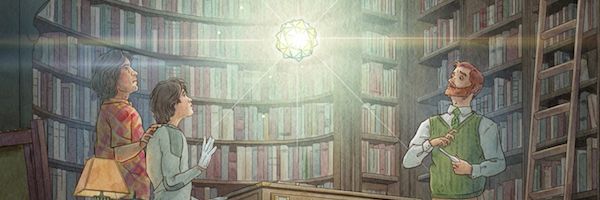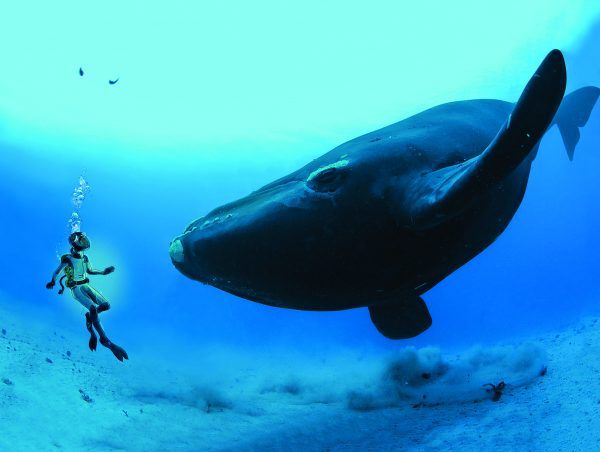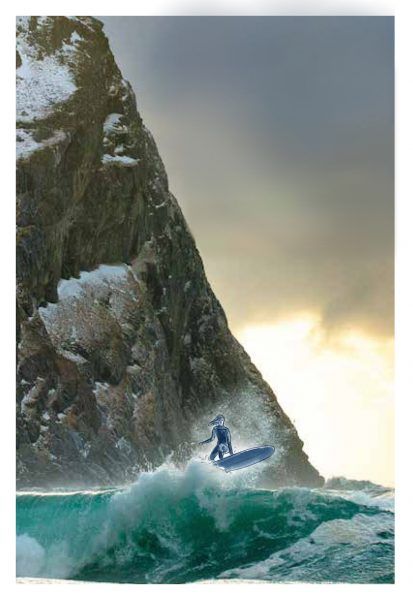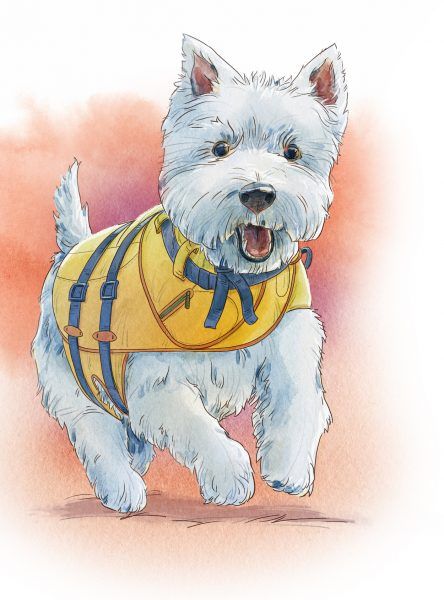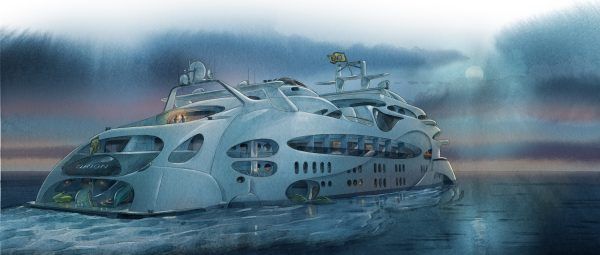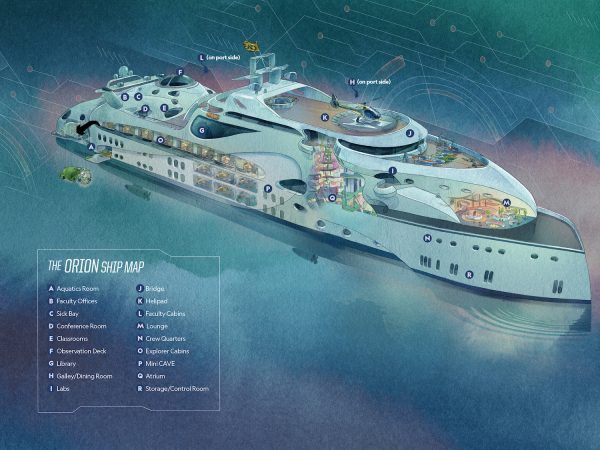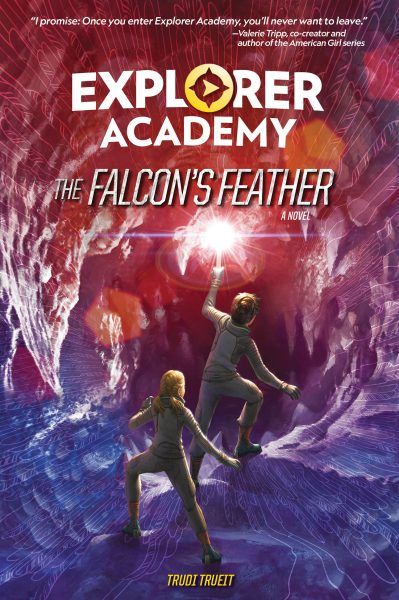In Part One of our Collider Kids Exclusive, we brought you an early look at gorgeous sketches and illustrations from The Falcon's Feather, the second book in National Geographic's Explorer Academy series. Author Trudi Trueit's fiction series, inspired by the real-life science, exploration, and mission of the National Geographic Society, began with The Nebula Secret as the first major movie into fiction for National Geographic Kids. Now, Part Two of our exclusive is here!
We spoke with Eva Absher-Schantz, vice president of visual identity at National Geographic Kids and head of design for the seven-book Explorer Academy series, to see how the beautiful design and compelling cover art came to be. As a bonus, we'll also be giving five (5) lucky readers a copy of Explorer Academy: The Nebula’s Secret and Explorer Academy: The Falcon’s Feather!
If you're not familiar with Explorer Academy, the series follows 12-year-old Cruz Coronado as he leaves behind his home in Hawaii to attend the prestigious Explorer Academy, where he and 23 other students from around the globe will train to become the next generation of great explorers. In the midst of code-breaking and cool classes, new friends and amazing augmented-reality expeditions, Cruz discovers a mysterious past that could jeopardize his future. Now, in the exciting follow-up story, Cruz, Sailor, and Emmett, along with their new ally Bryndis, embark on their first globe-trotting mission aboard the ship Orion, setting sail for Iceland and Norway.
Explorer Academy: The Falcon’s Feather will be available for purchase on March 19th for $16.99. It is currently available for pre-order here. Before we get to the interview--and our epic giveaway!--take a look at the newly released book trailer below:
The Falcon’s Feather, the second book in the thrilling new Explorer Academy series, ups the stakes for 12-year-old Cruz Coronado and friends, who are training to become the next generation of great explorers. The team gets to experience amazing expeditions and cool technology while aboard their classroom at sea, but for Cruz, danger lurks around every corner as Nebula continues to track his every move.
How did the Explorer Academy idea first come about, and how did you get involved?
Eva Absher-Schantz: The editors at National Geographic Kids wanted to create a science-based fiction series that drew from the lore of National Geographic and our long history of scientific exploration. Every year at our annual Explorers Festival at National Geographic, employees get to hear from our explorers who come back from the field and tell their amazing stories of scientific discoveries, planet conservation efforts, shoring up habitat loss for animals, and adventuring in the deep sea. It’s an inspiring week-long event and something I look forward to every year. We wanted to draw from those real and incredibly inspirational stories but inside of a fictional world to connect kids with this content in a fun, immersive way. Thus the Explorer Academy series was born!
I’ve read your write-up at the National Geographic page about crafting the look of this epic, seven-book series, but can you sum up the design process and how you found the right balance of more-vs-less artwork in the books?
Absher-Schantz: That was tough to get right and I’m grateful to our sales and distribution partners at Penguin Random House for helping us to balance it. Being an avid reader of fiction both as a kid and as an adult, I was keenly aware of not wanting to interrupt the reading experience with too many visuals or to take away from the key moments of the story. Instead, I see using illustrations as moments to help further the understanding of the place and to increase the moments of tension and emotion. I also relied on the insights from our National Geographic “Kids Panel,” which is comprised of 2,000 kids between the ages of 8-12, to help me determine how much is too much. While they all liked the illustrations when we tested the book with them, many of the older kids in that segment thought that we should leave more up to the imagination. So, I did some hard work on the first book in the series, Explorer Academy: The Nebula Secret, and cut back the number of illustrations overall. Luckily, we were able to use most of the unpublished art on our website and in our video trailer! I also radically scaled back the design on the book and the amount of color I was using on the openers. Initially, the chapter openers were all illustrated spreads with full-bleed color backgrounds, maps and ¾ illustrations. However, I found that sometimes using a chapter opener was asking me to show something in the story I wasn’t ready to show, so I’m glad that the National Geographic Kids Panel wanted to have a less splashy design. In the end, we went with a more traditional fiction book design that helps the story overall. The openers with the topographic map patterns overlaid with watercolor and maps help to set the scene but also let the reader move onto the words and immerse in the story.
How important was it to portray characters who would represent the many different types of readers who would be enjoying the story?
Absher-Schantz: It was really important to the editors, author, and myself to have a diverse and geographically balanced group of kids within the Explorer Academy series. We wanted to make sure that we were representing kids from all across the world so that this story could truly be global. Each character has their own story to tell but also can connect with one another. For example, I think it’s so cool that Cruz connects with Bryndis over surfing even though she grew up surfing in a heavy wetsuit in Iceland and he in sunny Hawaii.
Fun Fact! We used an incredible photo from photographer, Chris Burkard, who let us take out the original surfer and illustrate Bryndis in the same pose. Photography shows kids how beautiful and precious our planet is in a whole new way through fictional storytelling.
The cover illustrations by Antonio Javier Caparo are stunning; they really draw your eyes to them in the bookstore. But the readers had a hand in picking the cover of the second book, The Falcon’s Feather. How did Caparo’s art, your design instincts, and the opinions of fans of Explorer Academy come together to create the final cover illustration?
Absher-Schantz: Antonio Javier Caparo’s art is AMAZING. He is incredibly talented. I had originally wanted the characters to be more front and center on The Falcon’s Feather cover along with the ship and the “nebula,” but feedback from our partners indicated that we should go a more traditional fictional route. That’s when I brought in Antonio to create three totally different concepts for the cover, which we then tested with the Nat Geo Kids Panel.
One of the covers was of the dramatic moment at the beginning of the first book, The Nebula Secret, when Cruz is grabbed by a shadowy figure underwater. The editor and I both loved that cover and the concept and really wanted it to be the cover of our book. However, the kids just weren’t drawn as much to it as they were of Cruz and Sailor jumping in the waterfall in the C.A.V.E. version of the Oyamel forest. It was hard to let go of that concept, but I strongly believe that you have to listen to the research, especially when your audience is kids 8-12. They bring an entirely different perspective to design and illustration and, as adults, we often forget what that kid perspective is. Even after designing for kids for the past 15 years, I am often still sometimes surprised at what they choose and why.
I’m so happy that National Geographic believes in reaching out to them. We have built our entire design philosophy in nonfiction publishing around this kid perspective, and we will continue to build on that with the fiction properties. And now when I look at the cover of The Nebula Secret, I am so happy with the concept they chose. It makes an incredible book cover and lets readers imagine themselves in the moment.
Fun Fact! The original cover with the faces forward (illustrated by Scott Plumbe and photo illustrated by myself) is being used in Brazil! So sometimes, culturally, what we like in the U.S. isn’t what will work in other international markets.
For The Nebula Secret, the cover illustration teased a dangerous plunge over a waterfall, though readers may know that the Computer Animated Virtual Experience (C.A.V.E.) is a sort of virtual training ground for the explorers. Now, The Falcon’s Feather teases an intimidating cave mouth, possibly out in the real world since the explorers will head beyond the boundary of their school. What does this cover tease about the story to come?
Absher-Schantz: The cave featured on The Falcon’s Feather cover isn’t in the C.A.V.E. but actually in the real world and is supposed to be in Iceland’s Langokull (laughing dragon) caves. Cruz and Bryndis are featured on this cover making a treacherous journey to find another clue from his mom. The feathers along the cave walls are also significant. (Pay attention to what happens in the Svalbard Global Seed Vault!) The illustration of the characters going in the bank is also part photograph/part illustration. The building is so incredible, though, that you would almost never guess it wasn’t an illustration.
The illustrations by Scott Plumbe and other artists throughout the books are equally gorgeous. Some are reminiscent of National Geographic’s acclaimed nature photography and others are necessary for the code-breaking aspect of the story. How did this hybrid visual storytelling style come about?
Absher-Schantz: Since so much of the Explorer Academy story takes place in real places, I wanted to show kids the real-life beauty of these incredible geographic locations to further emphasize how amazing our planet is and how worthy it is of our care. One of the most amazing parts of my job is getting to review incredible photography and I didn’t think some of it could be improved upon by illustrating it. Plus, I know from our research with the Kids Panel how much they like to see real places and things. So, I mixed these two mediums to further reinforce that this is a fictional story with fictional characters but in real-world places that they can travel to, with real science that National Geographic Explorers are involved in. I’m also glad, though, that for the pieces that are all illustration, that I have Scott Plumbe involved. He has traveled extensively and is also so appreciative of the real places and of getting the illustrations factually correct as well as visually stunning.
There are over 65 illustrations in this book alone! Did any illustration or concept prove particularly challenging this time around?
Absher-Schantz: The thing that took the most time for the second book, The Falcon’s Feather, was getting the Explorer Academy uniform just right! Scott illustrated a study on Bryndis (that will be used in an activity book that’s publishing Fall 2019). It took many versions to get down what the author was going for and getting it to look cool, tech-y and something that kids would aspire to wear—a very tall order! We needed to get it right since it will be in many illustrations for the rest of the series.
When it comes to deciding on which illustrations to include, do you and your team take the lead from author Trudi Trueit’s words and Dr. Gareth Moore’s puzzles, or vice versa?
Absher-Schantz: Trudi Trueit, the author, makes art concept suggestions in her manuscript that I sometimes pick up and use entirely as they are. Other times, I decide to illustrate something else in the scene or in the chapter since I have to carefully weigh the visual pacing of the novel. And, again, it’s so important to not interrupt the reading experience but to use the illustrations to either further the moment that is about to unfold or use it to help the reader get a better sense of place. The codes are often incorporated at various stages of the development process. Trudi makes some coding suggestions while she writes, and Dr. Gareth Moore takes it to the next level after the manuscript is in its first stages. Then I try to incorporate as many of those ideas as I can. Finally, when the book is in the second to third pages stage (full layout, sketches complete), we make final touches to the codes.
I love that the books continue in National Geographic’s mission to encourage and inspire readers to explore and protect the planet while also carving out space for real-world scientists in “The Truth Behind the Fiction.” How has the response been to the Explorers Academy story so far?
Absher-Schantz: The response has been overwhelmingly positive so far, from kids, parents, librarians, and teachers alike who are reading the story. I’m so pleased that many of the reader comments also mention the art and design.
I’m also a big fan of the animated clips that tell parts of the Explorer Academy story in a new way. Do you have a hand in their creation as well?
Absher-Schantz: I love the animated pilot so much! (Up on ExplorerAcademy.com.) I was so pleased in consulting with the team to get the look of the places and the characters exactly right and to match with the characters in the book but in a new, fun style.
I, for one, am very excited to see where the series goes from here, if only to glimpse the beautiful artwork. What can you tease about Book #3, The Double Helix, even if it’s just a hint at the designs and illustrations you’re considering?
Absher-Schantz: Book 3, The Double Helix, features my favorite cover illustration so far! It is incredible and takes place in a very cool location (which I’m not able to disclose just yet!). It’s so exciting to be in yet another part of the world with this book!
Explorer Academy: The Nebula Secret is available now, and The Falcon’s Feather will be available for purchase on March 19th for $16.99. It is currently available for pre-order here. But for a chance to get your hands on a copy of each book, follow our giveaway instructions below:
To enter, please email collider.giveaway@gmail.com with the subject line “Explorer Academy Giveaway.” Five (5) lucky winners will get a copy of both books. U.S. residents only, sorry! Enter by Friday 2/22.

